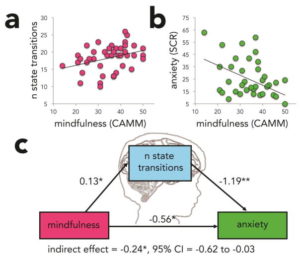Improve Adolescent Emotion Regulation and Mental Health with Mindfulness
By John M. de Castro, Ph.D.
“But a growing body of evidence suggests that mindfulness practice could be beneficial to teens, helping them cultivate empathy, as well as skills for concentration and impulse control. In short, mindfulness can help adolescents navigate the challenges of adolescence.” – Sarah Rudell Beach
Adolescence is a time of mental, physical, social, and emotional growth. But adolescence can be a difficult time, fraught with challenges. During this time the child transitions to young adulthood; including the development of intellectual, psychological, physical, and social abilities and characteristics. There are so many changes occurring during this time that the child can feel overwhelmed and unable to cope with all that is required. Indeed, up to a quarter of adolescents suffer from depression or anxiety disorders, and an even larger proportion struggle with subclinical symptoms.
Mindfulness training in adults has been shown to reduce anxiety, depression, and perceived stress levels and improve emotional regulation. In addition, in adolescents it has been shown to improve emotion regulation and to benefit the psychological and emotional health. There is a need to explore the relationship between these effects of mindfulness training in adolescents.
In today’s Research News article “Adolescents’ Mindfulness and Psychological Distress: The Mediating Role of Emotion Regulation.” (See summary below or view the full text of the study at: https://www.ncbi.nlm.nih.gov/pmc/articles/PMC6567674/), Ma and Fang recruited middle school students between the ages of 12-18 years and had them complete scales measuring mindfulness, anxiety, depression, perceived stress, difficulties with emotion regulation, and emotion regulation.
They found that the higher the levels of mindfulness, the lower the levels of anxiety, depression, perceived stress, and difficulties with emotion regulation, including all subscales; “lack of emotional clarity (Clarity), difficulty in engaging in goal-directed behavior under negative emotions (Goals), loss of control under negative emotions (Impulse), limited strategies for emotion regulation (Strategies), and non-acceptance of emotional responses (Non-acceptance).” Using a mediation model, they found that high levels of mindfulness were related to lower levels of anxiety, depression, and perceived stress directly and indirectly as a results of mindfulness’ negative relationship with difficulties with emotion regulation. In other words, mindfulness was directly related to lower levels of psychological distress and also indirectly by its relationship with lower levels of difficulties with emotion regulation which were in turn related to less psychological distress.
The study is correlational and as such causation cannot be concluded. But prior research has demonstrated that mindfulness causes reductions in anxiety, depression, perceived stress, and difficulties with emotional regulation. Hence, it would be reasonable to conclude that the present findings were also due to the effects of mindfulness on psychological health.
Adolescence is a time of strong emotions that the adolescents have not yet learned how to effectively regulate. This makes this period of life very difficult with high levels of emotional distress. The finding though indicate that mindfulness may be a way to mitigate the emotional upheavals of adolescence of improve the psychological health of the teens by improving their ability to deal with their emotions.
So, improve adolescent emotion regulation and mental health with mindfulness.
“Mindfulness teaches teenagers to recognize the downward spiral of thoughts before it gets out of hand, perhaps learning to label it as simply “worrying.” They can acknowledge the anxiety without getting caught up in it, without it leading to the rumination that ultimately ruins their mood.” – Sarah Rudell Beach
CMCS – Center for Mindfulness and Contemplative Studies
This and other Contemplative Studies posts are also available on Google+ https://plus.google.com/106784388191201299496/posts and on Twitter @MindfulResearch
Study Summary
Ma, Y., & Fang, S. (2019). Adolescents’ Mindfulness and Psychological Distress: The Mediating Role of Emotion Regulation. Frontiers in psychology, 10, 1358. doi:10.3389/fpsyg.2019.01358
Abstract
Mindfulness has been widely linked with psychological well-being in general population. There are emerging studies supporting the relationship between adolescents’ mindfulness and their mental health. However, the mechanisms through which mindfulness may influence adolescents’ psychological distress have only recently been explored, and more related research is still needed. This study investigated the relationship between adolescents’ dispositional mindfulness and psychological symptoms of depression, anxiety and stress. The mediating variables were also explored in perspective of two common emotion regulation theories, which were measured through Difficulties in Emotion Regulation Scale (DERS) and Emotion Regulation Questionnaire (ERQ). DERS has been used as a comprehensive assessment of emotion regulation difficulties. ERQ is also widely accepted to measure the emotion regulation process including dimensions of cognitive reappraisal and expressive suppression. Measures assessing mindfulness, emotion regulation, and psychological distress were administered to 1067 adolescents in mainland China. The results confirmed that adolescents’ dispositional mindfulness was negatively associated with depression, anxiety, and stress. DERS, especially the sub-dimensions of Acceptance and Strategies, significantly mediated the relationship between mindfulness and symptoms of depression, anxiety and stress. Whereas, ERQ including subscales of cognitive reappraisal and expressive suppression exerted limited mediating effect. These findings provided insights for the potential underlying mechanism between adolescents’ mindfulness and psychological distress, demonstrating that DERS might be more pervasive than ERQ. Further research was suggested to explore other mediating variables underlying mindfulness and psychological distress among adolescents and develop mindfulness-based programs to improve adolescents’ mindfulness and emotion regulation ability.
https://www.ncbi.nlm.nih.gov/pmc/articles/PMC6567674/









